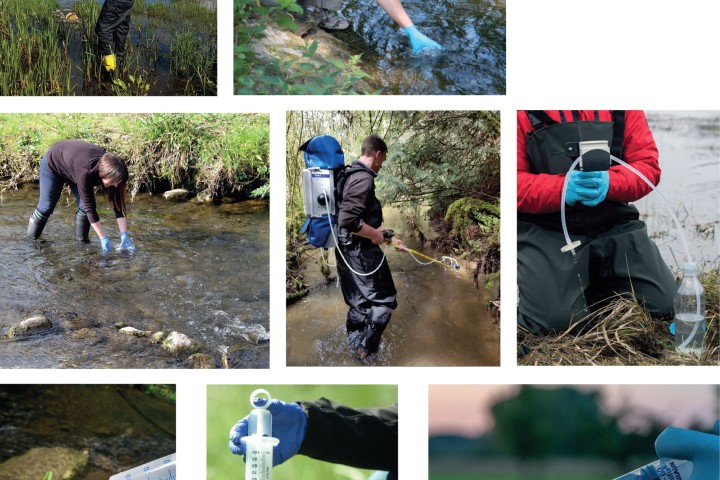Extensive practical guide to DNA-based biodiversity assessment methods

Between 2016 and 2021, over 500 researchers collaborated within the DNAqua-Net international network, funded by the European Union's European Cooperation in Science and Technology program (COST), with the goal to develop and advance biodiversity assessment methods based on analysis of DNA obtained from the environment (e.g. river water) or from unsorted collections of organisms.
Such innovative methods are a real game changer when it comes to large-scale assessment of biodiversity and ecological monitoring, as collecting environmental samples that are sent to the lab for analysis is much cheaper, faster and non-invasive, compared with capturing and examining live organisms. However, large-scale adoption has been hindered by a lack of standardization and official guidance.
Recognizing the urgent need to scale up ecological monitoring as we respond to the biodiversity and climate crises, the DNAqua-Net team published a guidance document for the implementation of DNA-based biomonitoring tools.
The guide considers four different types of samples: water, sediments, invertebrate collections and diatoms, and two primary analysis types: single species detection via qPCR and similar targeted methods; and assessment of biological communities via DNA metabarcoding. At each stage of the field and laboratory process the guide sets out the scientific consensus, as well as the choices that need to be made and the trade-offs they entail. In particular, the guide considers how the choices may be influenced by common practical constraints such as logistics, time and budget. Available in an Advanced Book format, the guidelines will be updated as the technology continues to evolve.
Leaders of DNAqua-Net are Prof. Dr. Florian Leese of the University of Duisburg-Essen (Germany) and Dr. Agnès Bouchez of the French National Institute for Agriculture, Food, and Environment (INRAE). The core writing team for the present guide book involves Dr. Micaela Hellström (MIX Research AB, Sweden), Dr. Kat Bruce (NatureMetrics Ltd., UK), Dr. Rosetta Blackman (University of Zurich and EAWAG, Switzerland), Dr. Sarah Bourlat (LIB/Museum Koenig, Germany), and Prof. Kristy Deiner (ETH Zurich and SimplexDNA AG, Switzerland).
"Back in 2016 we realized that all around the globe researchers are testing new eDNA methods, developing individual solutions and products. While this is excellent, we need to reach a consensus and provide this consensus to stakeholders from the applied sectors," says Florian Leese.
The guide's lead author Dr. Kat Bruce says, "The urgency of addressing the twin biodiversity and climate crises means that we need to accelerate the adoption of new technologies that can provide data and insights at large scales. In doing so, we walk a tricky line to agree on sufficiently standardized methods that can be usefully applied as soon as they add value, while still continuing to develop them further and innovate within the field. It was a daunting task to seek consensus from several hundred scientists working in a fast-moving field, but we found that our technology is based on a strong foundation of knowledge and there was a high level of agreement on the core principles—even if the details vary and different users make different choices depending on their environmental, financial or logistical constraints."
Looking back on the last four years that culminated in the publication of a "living" research publication, Prof. Dr. Kristy Deiner says, "The document took many twists and turns through more than ten versions and passionate discussions across many workshops and late night drinks. All in the days when we could linger at conferences without fear of the pandemic weighing on us. As we worked to find consensus, one thing was clear: we had a lot to say and a standard review paper was not going to cut it. With the knowledge and experience gathered across the DNAqua-Net, it made sense to not limit this flow of information, but rather to try and tackle it head on and use it to address the many questions we've all struggled with while developing DNA-based biodiversity survey methods."
Now that the document—or at least its first version—is publicly available, the researchers are already planning for the next steps and challenges.
"The bottom line is we've come a long way in the last ten years. We have a buffet of methods for which many produce accurate, reliable and actionable data to the aid of biodiversity monitoring and conservation. While there is still much work to be done, the many unanswered questions are because the uptake is so broad. With this broad uptake comes novel challenges, but also new insights and a diversity of minds with new ideas to address them. As said this is planned to be a living document and we welcome continued inputs no matter how great or small," says Deiner.
Dr. Micaela Hellström says, "The book evolved over the four years of COST Action DNAqua-Net which made it possible for the many scientists and stakeholders involved to collaborate and exchange knowledge on an unprecedented scale. Our whole team is well aware of the urgent need to monitor biodiversity loss and to provide accurate species distribution information on large scales, to protect the species that are left. This was a strong driving force for all of us involved in the production of this document. We need consensus on how to coherently collect biodiversity data to fully understand changes in nature."
"It was a great and intense experience to be a part of the five-person core writing team. In the months prior to submitting the document, we spent countless hours, weekends and late nights researching the field, communicating with researchers and stakeholders, and joining vivid Zoom discussions. As a result, the present book provides solid guidance on multiple eDNA monitoring methods that are—or will soon become—available as the field moves forward."

